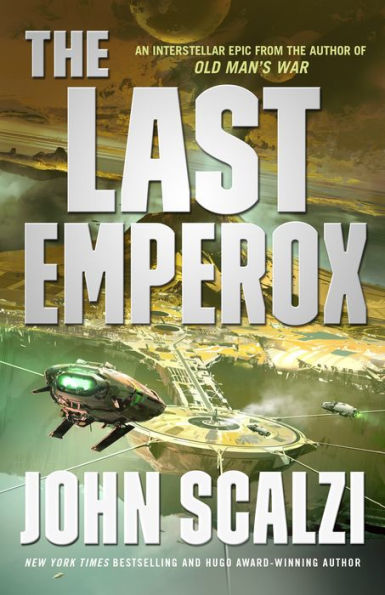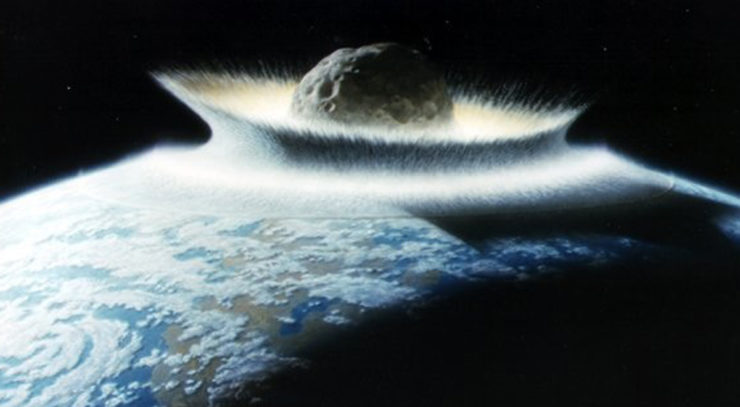No doubt many of you are already worrying about tax season. How wonderful it would be, some of you might think, if only some dramatic event were to scour all life from this planet, and in so doing spare you the need to look for misplaced receipts.
Science fiction is full of such planet-scouring events. Lamentably, the odds of actually experiencing such a tax-avoiding major catastrophe are minuscule. But if you must dream, here are five possible (but not likely) escape hatches…
Meteor Impact
Any number of SF novels (and movies) have featured large objects from space recapitulating the K/T impact. Interestingly the sub-genre got its start before the discovery of Chicxulub’s role in the extinction of the dinosaurs: impact novels like Lucifer’s Hammer and Shiva Descending predated Penfield’s revelation of the impact crater on the edge of the Yucatan. So what sparked the earlier impact novels? It’s possible that one cause was J.E. Enever’s 1966 essay, “Giant Meteor Impact”…
…which detailed the effects of a—oh, I see you’ve guessed where I am going with this.
Unfortunately, with meteors you can have large or you can have frequent. To quote Meteorites, Impacts, and Mass Extinction:
The average interval between successive large impacts (large enough to affect the whole planet) is much longer than the lifespan of human civilization. The big ones are so infrequent that entire species have evolved and gone extinct no thanks to Everest-sized rocks. Smaller impacts are more frequent but much more limited in their effect. The odds that you will be in the right place at the right time to experience your own personal Deep Impact are dismal.
The odds of winning the lottery may also be low, but people do win the lottery. Waterloo Region won the space rock lotto back in the 1970s, when a celestial object’s path terminated in my part of Canada. In a cruel twist of fate, the object fragmented kilometres above the surface. Instead of a community-flattening blast wave that would surely have justified not doing my homework, all that resulted was twin explosions loud enough to scare the family goat.
Supervolcano
We live on a tectonically active planet. Past eruptions have been impressive. Not piddling little booms like Mount St. Helens (which ejected about 3 km3 worth of material) or Tambora (more than 40 km3), but truly impressive eruptions that covered entire continents in volcanic debris. Lake Toba’s eruption of 74,000 years ago ejected 2,800 cubic kilometres, while the Yellowstone eruption of 620,000 years ago ejected 1,000 cubic kilometres. Supervolcano eruptions can throw a spanner into the works across a continent (and they probably have significant short-term global climate effects as well). It’s not surprising they’re featured in novels like Harry Turtledove’s Supervolcano series.
Again, our fun is spoiled by the rule of thumb that large events are rare. Supervolcanoes erupt worldwide perhaps every 50,000 to 100,000 years. Species can expect to experience the effects of a handful of such events but mayfly individuals? Probably not.
There is a volcanic event even more momentous than the explosive sort of supervolcano: the formation of Large Igneous Provinces (LIPs) like the Siberian Traps or the Deccan Traps. In a LIP, eruptions recur over many millennia, depositing a million km3 or more of material in the process. Several mass extinctions coincide with the eruption of LIPs, the most impressive of which is the End-Permian extinction, in which the vast majority of life on Earth perished. Flood basalt events are rare in speculative fiction (The Fifth Season has one; I cannot think of a second example) but even more rare in real life, as one can deduce from the fact that we’re still alive.
Alien Invasion
Humans invade each other’s territory all the time. This behavior isn’t peculiar to us (see ants, for example) so it seems reasonable to suppose that if other intelligent species exist, they might share this predilection. To quote Mr. Wells:
Yet across the gulf of space, minds that are to our minds as ours are to those of the beasts that perish, intellects vast and cool and unsympathetic, regarded this earth with envious eyes, and slowly and surely drew their plans against us.
Buy the Book


The Last Emperox
Examples abound, from the comparatively optimistic versions like The War of the Worlds or Independence Day in which humanity ultimately prevails, to less optimistic versions like Men Like Rats, Age of Miracles, or Of Men and Monsters, in which humans are reduced to vermin. There are even novels like The Genocides, in which humanity is exterminated.
Now, alien invasion might be even less likely than a supervolcano. Unless one assumes implausible scientific breakthroughs, interstellar travel would be slow and difficult. What’s the point of an invasion force that takes centuries to arrive?
Then there’s the fact that we’ve seen no signs of intelligent life in our galactic neighborhood. No Dyson spheres, no radio signals, not even exo-atmospheric nuclear exchanges (which would be detectable across the galaxy). There is no evidence that the Earth has ever been visited in the distant past. For reasons that are at present unclear, we seem to be alone. To quote the sage of the Hundred Acre Wood, “Bother.”
Crashing Stars
The gulfs between the stars are dauntingly vast. Stars move, however, and in a galaxy of four hundred billion stars, pure chance dictates that from time to time stars should encounter each other. Stars don’t have to collide to have significant effects on the worlds that orbit them (although it would be spectacular if stars did smash into each other). A miss near enough to throw Earth into interstellar space (as featured in Leiber’s “A Pail of Air”) would be lethal. Even a minor alteration of Earth’s orbital eccentricity would be catastrophic. Even a passing star nudging a billion comets from the Oort Cloud into the inner system could be dangerous. Not due to possible impacts (because space is large and Earth small) but because they might shed enough dust to alter the climate.
The good news (at least for you tax-avoiders) is we know for a fact that the Sun has had and will have near misses close enough to affect us. 2MASS J0610-4246 may have passed within a light-year of us. Gliese 710 now seems likely to pass within a fifth of a light-year of us. But it will be a million years until it shows up. Nothing else seems close.
Supernovas
Supernovas are energetic enough to briefly outshine their home galaxies. If our Sun were to go supernova, the effects would be devastating. Naturally, SF authors too numerous to list have jumped on exploding-star plot potential. Astronomers have spoiled the fun by working out how and why supernovas occur and making an inventory of the stars of the proper sort to go kaboom. It turns out that at present there are no stars of the right age and mass close enough to the Solar System to threaten us. Betelgeuse is a promising supernova candidate, but it’s far enough away that a supernova wouldn’t affect us. There’s also the fact that the kaboom could happen at any time in the next hundred thousand years. A blink of the eye in cosmic terms, but of little interest to us mayfly humans with our tax forms and encroaching deadlines.
***
Alas, it’s all too clear that while Geological or Cosmic Dooms have happened and will happen, they don’t occur frequently enough to be of any use to us harried modern humans. If we want to destroy civilization or put an end to life as we know it, we’re just going to have to do it ourselves.
In the words of Wikipedia editor TexasAndroid, prolific book reviewer and perennial Darwin Award nominee James Davis Nicoll is of “questionable notability.” His work has appeared in Publishers Weekly and Romantic Times as well as on his own websites, James Nicoll Reviews and Young People Read Old SFF (where he is assisted by editor Karen Lofstrom and web person Adrienne L. Travis). He was a finalist for the 2019 Best Fan Writer Hugo Award, and is surprisingly flammable.












